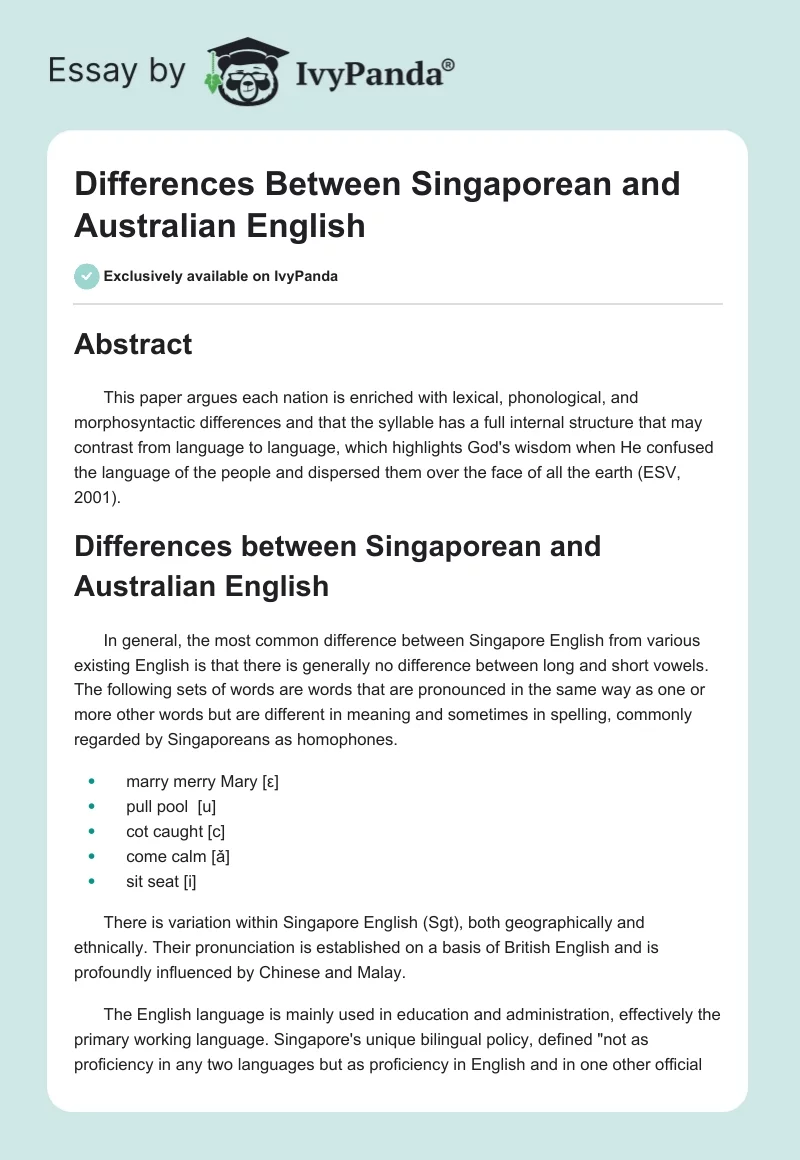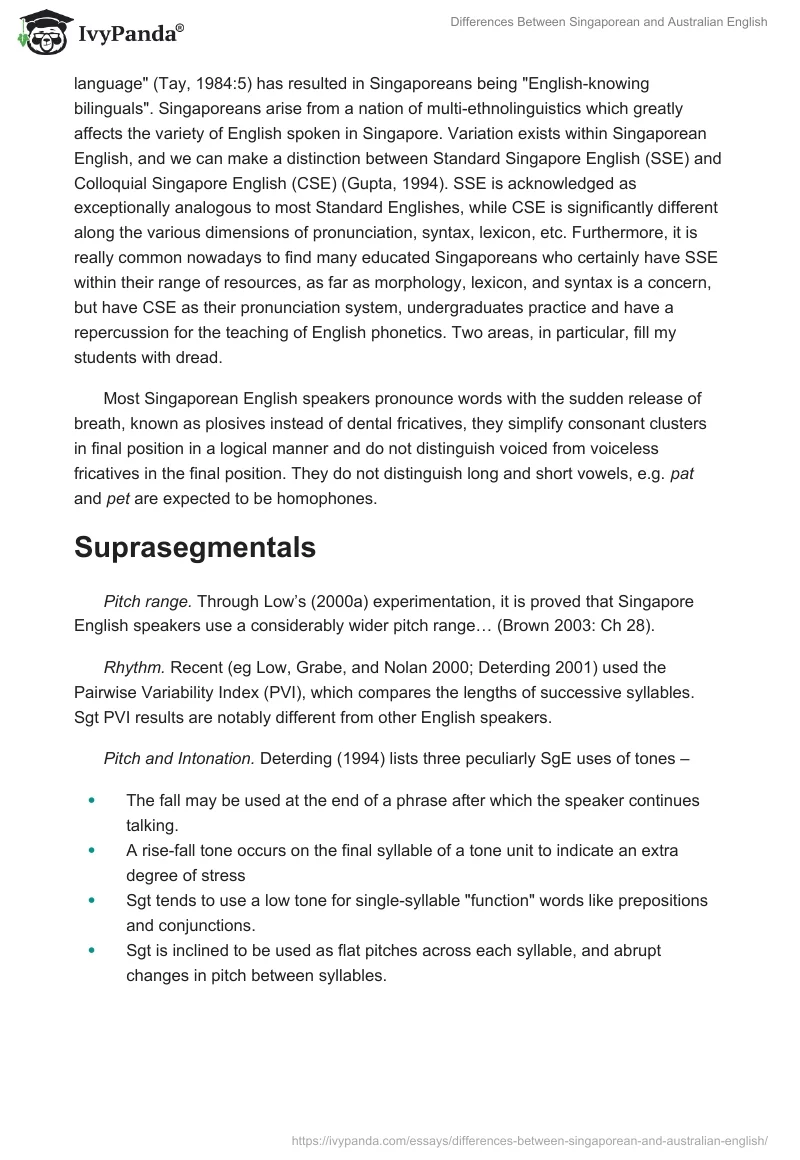Abstract
This paper argues each nation is enriched with lexical, phonological, and morphosyntactic differences and that the syllable has a full internal structure that may contrast from language to language, which highlights God’s wisdom when He confused the language of the people and dispersed them over the face of all the earth (ESV, 2001).
Differences between Singaporean and Australian English
In general, the most common difference between Singapore English from various existing English is that there is generally no difference between long and short vowels. The following sets of words are words that are pronounced in the same way as one or more other words but are different in meaning and sometimes in spelling, commonly regarded by Singaporeans as homophones.
- marry merry Mary [ε]
- pull pool [u]
- cot caught [c]
- come calm [ǎ]
- sit seat [i]
There is variation within Singapore English (Sgt), both geographically and ethnically. Their pronunciation is established on a basis of British English and is profoundly influenced by Chinese and Malay.
The English language is mainly used in education and administration, effectively the primary working language. Singapore’s unique bilingual policy, defined “not as proficiency in any two languages but as proficiency in English and in one other official language” (Tay, 1984:5) has resulted in Singaporeans being “English-knowing bilinguals”. Singaporeans arise from a nation of multi-ethnolinguistics which greatly affects the variety of English spoken in Singapore. Variation exists within Singaporean English, and we can make a distinction between Standard Singapore English (SSE) and Colloquial Singapore English (CSE) (Gupta, 1994).
SSE is acknowledged as exceptionally analogous to most Standard Englishes, while CSE is significantly different along the various dimensions of pronunciation, syntax, lexicon, etc. Furthermore, it is really common nowadays to find many educated Singaporeans who certainly have SSE within their range of resources, as far as morphology, lexicon, and syntax is a concern, but have CSE as their pronunciation system, undergraduates practice and have a repercussion for the teaching of English phonetics. Two areas, in particular, fill my students with dread.
Most Singaporean English speakers pronounce words with the sudden release of breath, known as plosives instead of dental fricatives, they simplify consonant clusters in final position in a logical manner and do not distinguish voiced from voiceless fricatives in the final position. They do not distinguish long and short vowels, e.g. pat and pet are expected to be homophones.
Suprasegmentals
Pitch range. Through Low’s (2000a) experimentation, it is proved that Singapore English speakers use a considerably wider pitch range… (Brown 2003: Ch 28).
Rhythm. Recent (eg Low, Grabe, and Nolan 2000; Deterding 2001) used the Pairwise Variability Index (PVI), which compares the lengths of successive syllables. Sgt PVI results are notably different from other English speakers.
Pitch and Intonation. Deterding (1994) lists three peculiarly SgE uses of tones –
- The fall may be used at the end of a phrase after which the speaker continues talking.
- A rise-fall tone occurs on the final syllable of a tone unit to indicate an extra degree of stress
- Sgt tends to use a low tone for single-syllable “function” words like prepositions and conjunctions.
- Sgt is inclined to be used as flat pitches across each syllable, and abrupt changes in pitch between syllables.
Post-vocalic r
Singapore English and Australian English do not pronounce post-vocalic r (in words like car, park, and water). However, some younger Singaporeans are now beginning to use post-vocalic r, in imitation of American English. This is most likely in careful speech. For these speakers, pairs like duck/dark, pot/port are then distinguishable. The use of post-vocalic r could improve intelligibility considerably for many clients.
However, Australian English (Aus) established its most significant lexical development in recent decades which is influenced by American English’s influx of words and expressions. Phonologically, Taylor notes, there has been a tendency for the stress patterns in certain words to move from a traditional British to an American pattern (e.g. finANCE to FINance, reSEARCH to REsearch). Graphologically, simplification of digraphs such as [ae] and [oe] in medieval and fetal, follows American practice. Syntactically, amongst other things, the American-influenced elision of the in the structures of the type I play (the) piano.
Multiculturalism is evident in the lexical formation of Australian English since the commencement of large-scale immigration at the end of World War II. Terms of foods and drinks are introduced by migrants from a variety of language backgrounds; examples are cappuccino, goulash, souvlaki, and hummus which Clyne, Eisikovits, and Tollfree note as a tangible indicator of multiculturalism.
Syntax and morphology. According to Newbrook, Aus permits both singular and plural concord with the names of sports teams and other singular collective proper nouns (e.g. North Melbourne are playing well). Contractions are commonly used and are more frequently distributed in non-fictional genres in AusE.
Phonology. Cox’s study of noticeable time differences in Bernard subjects suggests a movement away from Broad with /u/ (towards reduced on gliding) and with /oo/ (towards a more retracted first target), and a movement away from Cultivated with /iə/ (towards monophthongization).
Tollfree’s finding shows a high frequency of reduced forms of /t/ in everyday conversation, either tapped or glottalized. Borowski’s study shows that the vocalization of dark l is highly context-dependent: l have a tendency to be vocalized especially when it is syllabic, followed by a consonant or preceded by a back vowel, therefore both syllable position and adjacent reverse (of either vowel or consonant) are predisposing elements.
Conclusion
Multiculturalism serves as a major factor in the occurrence of lexical, phonological, and morphosyntactic differences in SgE and AusE, and it is true to all the existing languages today whether spoken or written. Language also indicates how rich the culture of one nation is and it serves not as a barrier among nations but as a symbol of social identity.
References
- Bao Zhiming. “Syllabic Constituency and Sub-syllabic Processes.”
- Gupta, Anthea Fraser. “Singapore English: Pronunciation.”
- Phonology. Web.
- Phonetics and Phonology. Web.
- Gupta, Anthea Fraser. “Singapore English Speech Language Pathologists.”
- The Bible. English Standard Version, 2001. Crossway Bibles. (Genesis 11.6-9).
- Collins, Peter and Blair, David. “Language and Identity in Australia.”
- Brown, Adam and Deterding, David. “A checklist of Singapore English pronunciation features.” Phonetic Research on a Corpus. McGraw-Hill Education (Asia) 2005.


